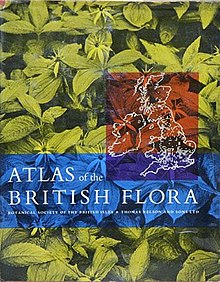Stuart Max Walters was a British botanist and academic. As a conscientious objector in the Second World War, he worked as a hospital orderly in Sheffield and Bristol. He was Curator of the Herbarium, Botany School, University of Cambridge 1949-73, Lecturer in Botany 1962-73, and for the ten years up until his retirement, 1973–83, Director of the University Botanic Garden in Cambridge, of which he wrote a history. He was a Research Fellow at St John's College, Cambridge 1948-51 and Fellow of King's College, Cambridge 1964-84.
The Biological Records Centre (BRC) established in 1964, is a national focus in the UK for terrestrial and fresh water species recording.

The Botanical Society of Britain and Ireland (BSBI) is a scientific society for the study of flora, plant distribution and taxonomy relating to Great Britain, Ireland, the Channel Islands and the Isle of Man. The society was founded as the Botanical Society of London in 1836, and became the Botanical Society of the British Isles, eventually changing to its current name in 2013. It includes both professional and amateur members and is the largest organisation devoted to botany in the British Isles. Its history is recounted in David Allen's book The Botanists.

Viola lutea, also known as the mountain pansy, is a species of violet that grows in Europe, from the British Isles to the Balkans.

Clive Anthony Stace is a British botanist and botanical author. His academic career was based at the University of Leicester, where he held the post of Professor of Plant taxonomy. He is a past president of the Botanical Society of Britain and Ireland.
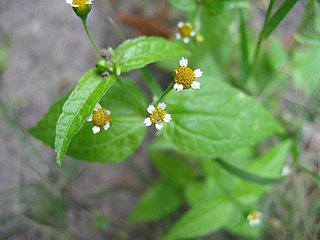
Galinsoga parviflora is an herbaceous plant in the Asteraceae (daisy) family. It has several common names including guasca (Colombia), mielcilla, galinsoga, gallant soldier, quickweed, and potato weed.

Artemisia campestris is a common and widespread species of plants in the sunflower family, Asteraceae. It is native to a wide region of Eurasia and North America. Common names include field wormwood, beach wormwood, northern wormwood, Breckland wormwoodboreal wormwood, Canadian wormwood, field sagewort and field mugwort.

Selaginella selaginoides is a non-flowering plant of the spikemoss genus Selaginella with a wide distribution around the Northern Hemisphere. It resembles a moss in appearance but is a vascular plant belonging to the division Lycopodiophyta. It has a number of common names including lesser clubmoss, club spikemoss, northern spikemoss, low spikemoss and prickly mountain-moss. This plant has one close relative, Selaginella deflexa, native to Hawaii. These two plants form a small clade that is sister to all other Selaginella species.

Lemna gibba, the gibbous duckweed, swollen duckweed, or fat duckweed, is a species of Lemna (duckweed). It has a simple plant body, known as a thallus, which floats on the surface of the water and measures 3 – 5 mm in diameter. A single root hangs down into the water. Found in a wide range of still or slow-flowing water bodies, this common duckweed can also grow on mud or damp rocks.
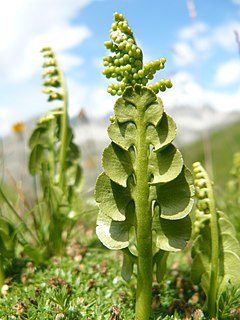
Botrychium lunaria is a species of fern in the family Ophioglossaceae known by the common name moonwort or common moonwort. It is the most widely distributed moonwort, growing throughout the Northern Hemisphere across Eurasia and from Alaska to Greenland, as well as temperate parts of the Southern Hemisphere.

Helminthotheca echioides, known as bristly oxtongue, is a stiff annual or biennial herb native to Europe and North Africa. It was traditionally used as an antihelminthic treatment.

Lepidium didymum, synonym Coronopus didymus, the lesser swine-cress, is a species of flowering plant in the cabbage and mustard family Brassicaceae.
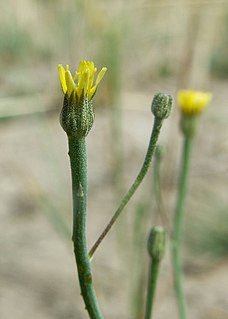
Arnoseris is a monotypic genus of flowering plants in the daisy family.

Luzula pilosa is a species of flowering plant in the rush family Juncaceae with the common name hairy wood-rush. The plant is native to northern Europe and western Asia.
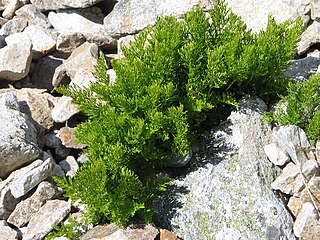
Cryptogramma crispa, the parsley fern, is an Arctic–alpine species of fern. It produces separate sterile and fertile fronds, up to 30 cm (12 in) tall, and is a pioneer species on acidic screes.

Carex spicata is a species of sedge in the genus Carex.
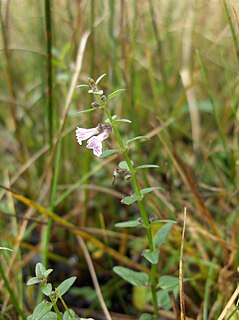
Scutellaria minor, the lesser skullcap, is a species of flowering plant in the family Lamiaceae.
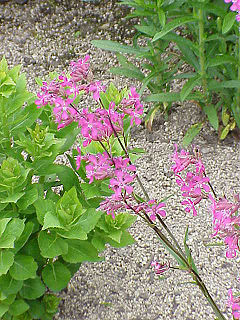
Silene viscaria, the sticky catchfly or clammy campion, is a flowering plant in the family Caryophyllaceae.
David Allardice Webb or D. A. Webb was an Irish botanist and chair of botany at Trinity College, Dublin from 1949 to 1966. He was son of George and Dr Ella Webb. In Ireland he had studied under Henry Horatio Dixon and also studied in the United Kingdom. In addition to botany he edited a history of Trinity College with R. B. McDowell and published a book on the history of art in Trinity College. In 1982 he received the Boyle Medal of the Royal Dublin Society. His botanical specialties included his work as a leading taxonomist of Saxifraga. He died in a car accident on his way to the University of Reading's herbarium. The 8th edition of An Irish Flora was renamed Webb's An Irish Flora in his honour.

Doronicum pardaliances, known as leopard's-bane, like other members of the genus Doronicum, is a rhizomatous herbaceous perennial in the sunflower family Asteraceae. It has upright stems growing to 80 cm (31 in), with heart-shaped basal leaves and yellow flowers, generally 3–4 cm (1.2–1.6 in) across. It is native to western Europe and was introduced to the British Isles, where it was first recorded in Northumberland in 1633.
